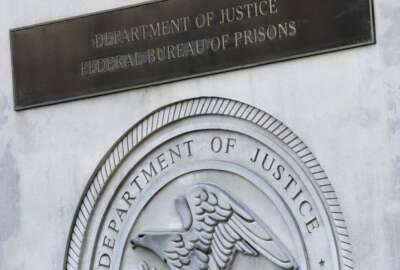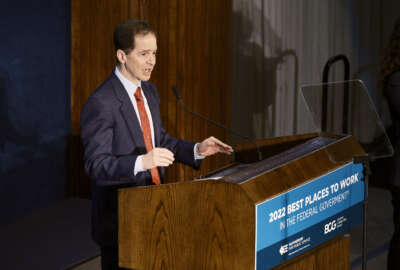
Facing low morale and expiring authorities, can DHS’s CWMD office turn a corner?
The office has a short but turbulent history, and its employee engagement scores are among the worst in the entire federal government.
The Department of Homeland Security’s Countering Weapons of Mass Destruction office, facing employee engagement scores near the bottom of the federal government, is hoping to turn a corner in the coming years with the pending reauthorization of the office moving forward in Congress.
DHS has consistently ranked near the bottom of the 17 “large” agencies in the “Best Places to Work in the Federal Government” rankings compiled by the Partnership for Public Service. Those low scores are largely driven by challenges at large DHS components like Customs and Border Protection, Immigration and Customs Enforcement and the Transportation Security Administration.
But the component with the lowest employee engagement score in all of DHS is the little known Countering Weapons of Mass Destruction office. Its employee engagement score of 39.4 in 2022 ranked 430th out of 432 subcomponents across the entire federal government.
With approximately 230 employees, the CWMD office is responsible for working with state and local governments as well as international partners to guard against chemical, biological, radiological and nuclear threats to the United States.
“CWMD really has as a sweet spot in its role as a convener and as the outreach arm to first responders to provide equipment, to provide training,” Allison Bawden, director of the Government Accountability Office’s natural resources and environment team. “That’s a really important role for the office and can be very empowering, when that mission is clear.”
Formally established in 2018, the CWMD office has had a turbulent short history, with multiple changes in organizational direction, structure, leadership and even office locations in less than five years. The office’s employee engagement scores had steadily risen in 2020 and 2021, but the latest scores represent a significant backtrack on that progress.
Congress is now considering further updates to DHS’s CWMD mission as it looks to reauthorize the office by the end of this year.
But Gary Rasicot, who has led the office as the acting assistant secretary for CWMD since January 2021, is “optimistic” that the organization will improve on its morale metrics.
“I think we’re through the worst of it,” Rasicot said in an interview.
‘A lot of unknowns’
The CWMD office was created when DHS leadership in 2017 decided to merge the Domestic Nuclear Detection Office and the Office of Health Affairs. Congress codified the office into law in 2018.
From the start, the merged organization faced challenges with employee engagement. It ranked the lowest out of all federal agency subcomponents in the Partnership’s 2019 rankings.
One of the root causes of the low scores was a clash of different cultures between the two legacy offices, according to a GAO report from April 2022. While DNDO worked with physicists and law enforcement officials to detect and prevent threats, OHA was more focused on working with public health officials to coordinate preparedness and response, GAO reported.
Additionally, a 2019 Los Angeles Times investigation found the Trump administration quietly dismantled or scaled back multiple counter-WMD programs around the time of the merger, leading to widespread employee dissatisfaction and uncertainty. The official leading those efforts at the head of the CWMD office resigned in 2019, just a year after the office was formally stood up.
The young office has been challenged by turnover within the senior leadership ranks, according to GAO, as it’s had three different assistant secretaries at the helm since its formal establishment in 2018.
“We all can agree that leadership matters when we’re carrying out the work that we’re expected to carry out and just having that turnover over time, I think has been challenging for that office,” Tina Won Sherman, director of GAO’s homeland security and justice team, said in an interview.
In the Partnership’s 2022 employee engagement rankings, the two categories in the Federal Employee Viewpoint Survey (FEVS) where the CWMD performed the lowest are in “effective leadership: empowerment” and “senior leaders,” respectively.
Rasicot said CWMD leadership closely tracks the FEVS responses and acknowledged they show a “disconnection” between staff and senior leadership.
He said the shift to remote work and telework severed previous connections that the office is now looking to rebuild by putting out a weekly notice of what CWMD’s front office is doing; re-starting the “CWMD bulletin” that provided a biweekly update to staff on issues ranging from pay to IT issues; and pushing out more training opportunities to employees.
He also pointed to two specific challenges that may have upset morale at the CWMD office in 2022. The first was a change in location. Last April, the organization began shifting headquarters from downtown Washington, D.C., to the new St. Elizabeth’s campus in Southeast D.C.
The move to a new location, Rasicot said, coincided with uncertainty around whether employees would lose their workplace flexibilities and be required to report to the office more frequently. But he said CWMD has been a “champion” of remote work and telework among DHS components, and added that those flexibilities didn’t change after the move to St. Elizabeth’s.
“I firmly believe we’re in the third industrial revolution,” Rasicot said. “We won’t work, play or go to school again the same way we did in 2019. And I think if you try to go back to 2019, you’re not going to be competitive in recruiting and retention. So we’ve maintained the workplace flexibilities, but there was a lot of uncertainty between the move and the ending of COVID in ‘22, which I think led to some senior leader issues that we’ve addressed as well.”
The second major challenge last year was the decision to elevate a new Office of Health Security out of CWMD.
Rasicot called the reorganization a “very good move” allowing CWMD and the new Office of Health Security to focus on their respective missions, but said it was “another source of angst” within the organization in 2022.
“I think it’s been a hugely positive change,” he said. “And I think it’s playing out that way now for the staff as well. But in ‘22, there were a lot of unknowns. And so those are all those things combined to sort of just create a sense of unease a little bit.”
One of the keys moving forward, Rasicot said, will be communicating with staff across CWMD.
“We lost maybe a step on connecting with people and communicating, so we really reinvigorated that in the latter part of ‘22, once we had settled into the new building,” Rasicot said.
Sunset on the horizon
Meanwhile, the authorization for the CWMD office’s activities expires at the end of 2023. The pending sunset represents yet another potential source of uncertainty for CWMD employees, but Congress has taken some preliminary steps to address the office’s future.
In May, the House Homeland Security Committee advanced a bill that would permanently authorize the CWMD office and also codify the new Office of Health Security into law. Last week, the Senate Homeland Security and Governmental Affairs Committee approved a similar bill.
Both the House and Senate versions of the legislation would require DHS to present lawmakers with an “action plan and strategy to continuously improve morale” within the CWMD office.
While the office’s future is ultimately in congressional hands, Rasicot said it looks like the legislation is on the right track.
“Do I ultimately think it’s all going to work out? Sure, I honestly do,” Rasicot said. “But it also creates that angst and uncertainty, that we want to keep our workforce focused on the important work they do. This workforce is DHS’s best and brightest. I’ve never worked with a group this dedicated, energetic, or just to put it plainly, this smart ever in my life.”
Copyright © 2025 Federal News Network. All rights reserved. This website is not intended for users located within the European Economic Area.
Follow @jdoubledayWFED
Related Stories





